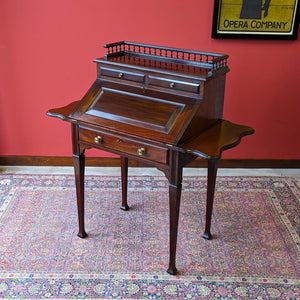Antique Side Table Buying Guide
Side tables may often be modest in scale, but they punch well above their weight in terms of their impact on a room's tone. Whether you’re drawn to the clean lines of Georgian design, the rich patina of well-worn country pieces or the decorative flourishes of the Victorian & Edwardian periods, the variety within this category is part of its appeal. You'll rarely be short on options to suit the precise mood you're after.
We source side tables in oak, mahogany, walnut, rosewood and other fine timbers, each selected for their grain, condition and natural beauty. Our collection often spans 18th, 19th and early 20th century forms, from simple country tables to refined Regency consoles and Victorian hall tables, with options suited to living rooms, hallways, studies, bedrooms and landings alike.
One good side table in a space can make everything else look considered. These are functional, beautiful pieces that sit easily in both period and modern interiors, offering a useful surface, while holding their own as a piece of thoughtful design.
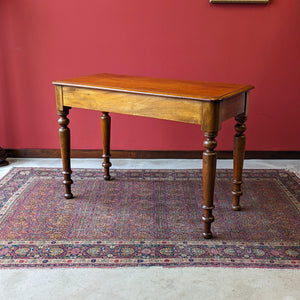
How Antique Side Tables Differ from Other Antique Tables
While the term “side table” is often used casually and interchangeably, antique side tables are quite a specific and recognisable category in traditional British furniture. Their form, scale and intended placement set them apart from other antique tables such as occasional tables, tea tables or writing tables, though some of these other forms may sit naturally within the boundaries of the side table category depending on their proportions and features.
Antique side tables were typically designed to sit permanently in position, often against a wall, flanking a fireplace or beside a larger piece of furniture. Normally of practical dimensions and providing a useful tabletop with subtly integrated storage.
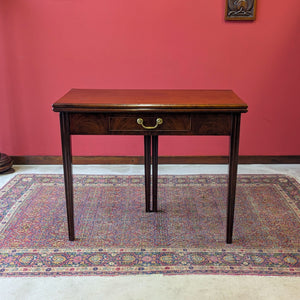
By contrast, antique occasional tables were made to be moved, typically lighter in build, more decorative in form and often circular or tripod-based. Tea tables and games tables often feature folding or swivel tops, designed for a specific function, but when closed, can function beautifully as side tables. Writing tables, while sometimes similar in size, are usually more substantial and were purpose-built for seated work, often with a leather writing surface or multiple drawers.
Understanding these distinctions matters when choosing the right piece for a room. An antique side table offers a balance of style and substance. A fixed, functional table designed to serve a purpose adding presence without demanding attention.
Common Styles and Forms of Antique Side Tables
Antique side tables appear in a wide range of styles, but certain forms recur consistently across English furniture of the 18th, 19th and early 20th centuries. Having a general idea of these variations can help you choose a piece that suits both your space and your taste.
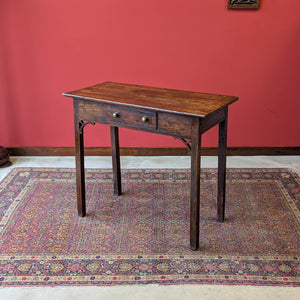
A staple, and for good reason, is the Georgian single-drawer side table, typically made in oak or mahogany. These are practical, rectangular tables with simple proportions, square or turned legs and a single working drawer.
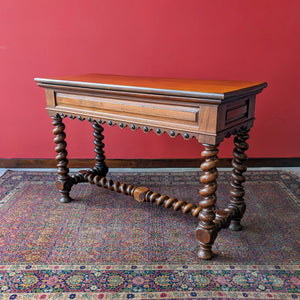
Console tables and pier tables were designed to sit against a wall, usually between windows or beneath mirrors. They tend to be narrower and often more decorative, sometimes with shaped aprons, serpentine fronts or carved detail.
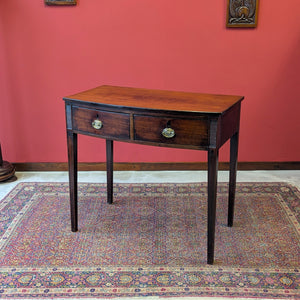
In more formal settings, serpentine-front or bow-front tables add visual interest and a greater sense of refinement. These are especially common in late Georgian and Regency pieces.
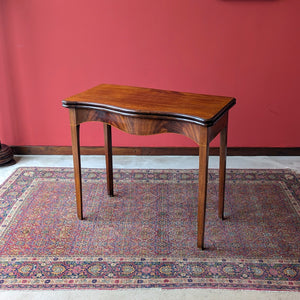
Some fold-over tea tables, card tables or games tables function beautifully as side tables when closed, and many people utilise them purely for this purpose. While technically multi-purpose pieces, their closed position proportions often mirror those of many traditional side tables. Similarly, smaller writing tables can work well as side tables in certain settings, particularly when the scale is modest and the design avoids the bulk or formality typical of larger desks.
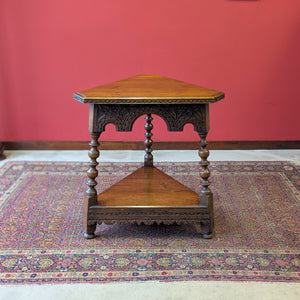
Most side tables were designed to sit against a wall, but others were intended for freestanding use beside a chair or in a more central position. These examples are generally more substantial, designed to be stationary in place and often finished on all sides so they sit comfortably away from the wall.
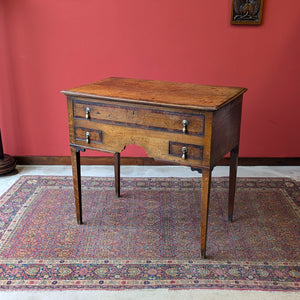
Lowboys are a distinct type of antique table that emerged in the early 18th century, most often used for dressing or writing, but now frequently repurposed as side tables. Typically featuring drawers, they are recognisable by their shaped aprons and cabriole or tapering legs. While commonly provincial and rather humble, other surviving examples show meticulous cabinet work and were made in high-quality timbers like walnut or mahogany. The term “lowboy” itself is a later collector’s label, but the form remains popular for its practical scale, decorative detailing and versatility within the home.
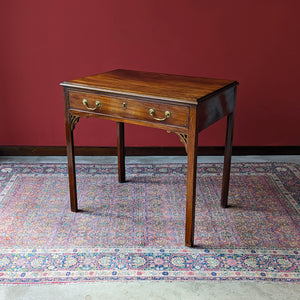
Whatever the form, antique side tables should offer a combination of proportion, practicality and period charm. Whether you’re looking for something refined and decorative or more understated and functional, there’ll normally be lots of options to pick from.
Antique Side Tables for Different Rooms
One of the reasons antique side tables remain so popular is their versatility, usability and potential to elevate a space. Originally made for daily life, they continue to offer a rare balance of practicality and poise that works beautifully in almost every room in the home.
In the hallway, a slim antique side table makes a natural hall table, offering a surface for lamps, post or keys without taking up much space. Georgian single drawer tables or narrow console tables work particularly well here, providing just enough storage to be useful without cluttering an entrance.
In the living room, antique side tables can sit beside a sofa or armchair, acting as lamp tables or simply a place to rest a book or drink. These settings suit a wide range of styles, from refined mahogany tables to more rustic oak or country pieces.
In the bedroom, smaller antique side tables can serve as distinctive bedside tables or dressing tables, offering character and useful storage, all with a more thoughtful sense of design.
In the study or home office, a well-proportioned side table can work alongside a desk or reading chair, perfect for stacking books, placing a reading lamp or simply adding depth and texture to the space. When space is limited, a side table, often more modest in scale than a typical desk, can serve as a functional writing surface in its own right.
Because antique side tables vary so widely in form, materials and dimensions, there is nearly always a piece that will work for the space you have in mind, whether it's a formal front room or a quiet landing.
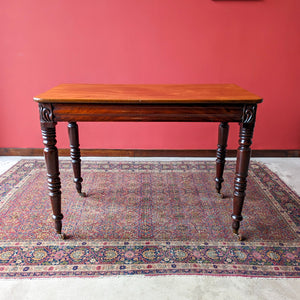
Woods Used in Antique Side Tables: What to Look For and Why It Matters
The choice of timber plays a defining role in both the character and quality of an antique side table. From rich, high-status hardwoods to more modest regional timbers, the wood used affects not just appearance, but also weight, feel and durability.
Mahogany features heavily in side tables from the Georgian right through to the Edwardian periods, chosen for its strength, fine grain and capacity for detailed craftsmanship. Its deep colouring and smooth finish made it the preferred choice for more formal pieces, particularly where elegance and proportion were key.
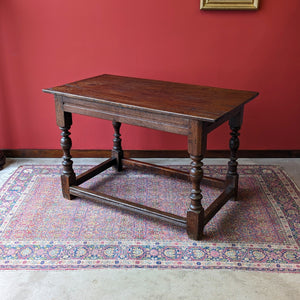
Oak is more robust in feel and typically associated with earlier or more provincial examples. It lends a certain honesty and solidity to a piece, especially in country-made side tables or simpler single drawer forms. Oak was widely used across the 18th and 19th centuries and ages with great dignity.
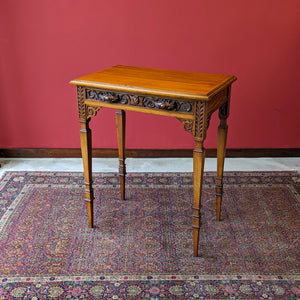
Walnut is seen less often in side tables but remains highly prized for its warmth and delicate grain. It appears most often in early Georgian pieces, where it complements flowing lines, shaped aprons and more decorative forms.
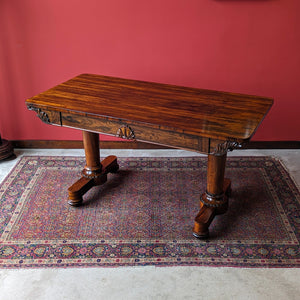
Rosewood appears less frequently in antique side tables and is most often found in finer Georgian or Regency examples. It’s prized for its dense grain, deep colour and natural sheen, and was typically used in veneers or decorative inlays rather than full construction. When present, it often signals a finer level of craftsmanship and a table made for a more formal interior.
When choosing a side table, it’s worth considering how the wood aligns with both the room and your wider furnishings. Trying to match woods exactly is rarely necessary and often leads to flat, overly coordinated interiors.
Each timber offers a different tone, weight and visual presence. Some buyers are drawn to deep colour and polish; others to patina and texture. Either way, the timber is more than a material, it’s a key part of the table’s story and affects how a piece will fit into your home. Remember, it’s not about rules, rather recognising what fits your eye and your lifestyle.
Antique Side Table FAQ's
What is an antique side table?
A small table designed for fixed use beside walls, seating or fireplaces. Often includes a drawer and was made for everyday function in 18th to early 20th century homes.
What should I look for when buying an antique side table?
Check proportions, wood type, condition and finish. Look for signs of age, quality joinery and whether it's finished on all sides if freestanding use is intended.
Can I place a side table in a hallway?
Yes. Narrow antique side tables make excellent hall tables, offering surface space for lighting, keys or post without overcrowding the space. Look for slim, single-drawer designs or console forms.
How should I clean or maintain an antique side table?
Use a soft, dry cloth for regular dusting. For deeper cleaning, a slightly damp cloth followed by buffing with a beeswax polish helps preserve the finish. Avoid silicone sprays and harsh chemicals.
Do side tables always have to match other furniture in the room?
Not at all. Antique side tables often work best as contrasting pieces, adding depth and interest. A thoughtful mix of materials, tones and periods can create a more layered, characterful interior.
Can antique side tables work in modern homes?
Yes. Their scale, character and craftsmanship make them ideal accent pieces in contemporary spaces, adding warmth and contrast without overwhelming the room.
What’s the best side table style for small spaces?
Compact one-drawer tables, demi-lune shapes or narrow consoles are ideal. Tables with a shallow depth or finished backs can also work well floated in tighter layouts.
Where should I place a side table in a room for the best effect?
That depends on the room’s layout, but common placements include beside seating, beneath artwork, in unused corners or flanking fireplaces. Aim for visual balance and easy access.
Not just somewhere to put your drink. Our antique side tables can bring character, balance and usefulness to your room, and they’re all ready to place. Every side table here has earned its history, now it’s ready for the next chapter.

































